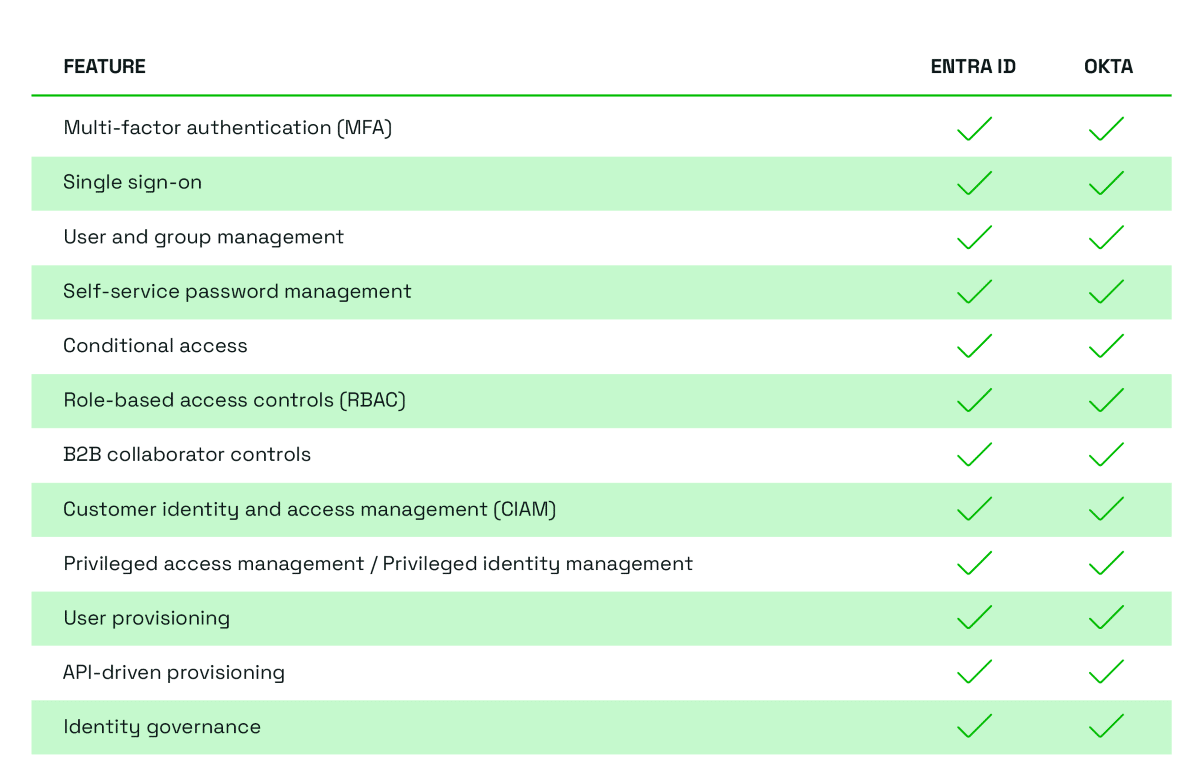If you’re invested in Microsoft technology, can Entra ID offer the right cloud-identity solution, or should you explore Okta?
Take a tour of Entra ID v Okta comparison pieces and you’ll see some familiar perceptions.
On the one hand, Entra ID is part of the Microsoft fabric. An advantage for those organisations already invested in Microsoft as it integrates seamlessly with the full suite of technologies.
On the other, Okta has established itself as a flexible choice for enterprises. A vendor-neutral solution with robust authentication, slick access controls, adaptable lifecycle management, and an array of integration capability with third-party providers.
Now, while these statements are true, they don’t tell the full story.
Like Okta, Entra ID offers a solution founded upon the idea of secure yet frictionless access. Of simplifying user provisioning, governance, and identity management across multiple cloud or on-premises providers.
In truth what we have is relative feature parity.

Choosing the solution for your organisation therefore, will basically come down to whatever’s right for your specific requirements, set-up, budget, and culture.
Let’s explore some of these factors a little more.


Free Guide
Everything you need to know about Microsoft Entra
The most comprehensive guide to Microsoft Entra. Over 40 pages. Plus, Microsoft licensing simplified.
Discover how you can:
- Cut costs by removing 50% management effort
- Elevate security – reduce breach chances by 45%
- Automate provisioning to ensure compliance
Can Entra ID match up to Okta’s flexibility?
One of Okta’s primary messages is the flexibility it derives from being vendor-neutral. It’s essentially saying that Okta is leading IAM technology that can be applied to any digital estate.
Which can be quite a compelling argument. Particularly as organisational ecosystems are growing increasingly diverse.
But what if you’re one of the million plus organisations who’s put their trust in the Microsoft ecosystem?
Can’t Entra ID offer what you need so that you can avoid adding yet another logo to your stack?
More often than not, the answer to that question is yes, it can.
Identity and access is an integral cornerstone of Microsoft’s security-first future.
This is evident from:
The huge expansion of its Entra family of identity products.
The release of new Entra ID features that unlock greater potential for cloud-agnostic access management.
Their positioning of IAM as the foundation of their zero trust approach to security.
The ‘Secure Future Initiative’ and their commitment to invest $20 billion in security over 5 years.
Increased integration capabilities to centrally manage multi-cloud and on-premises apps and resources.
Of course, flexibility isn’t measured on how neutral a platform is, but on how well it can be applied to meet your requirements. And, as is generally the case between two Gartner® Magic Quadrant™ for Access Management leaders, there’s little to choose between them.
Okta have certainly developed the platform to offer flexibility in the way access management and provisioning is deployed in an organisation. And, as we’ve discussed in previous articles, Entra ID’s capabilities around extensibility, custom workflows, and lifecycle management has expanded considerably as Microsoft continues the transition from legacy IAM to the cloud.
Both platforms will rightly point to their adaptability when it comes to tasks like:
User provisioning from any HR system or other source of truth.
Customisable and automated workflows across multiple apps and sources.
Assigning and revoking access rights to apps and resources from multiple providers.
API access management.
What about security, compliance, and authentication?
The challenge for any IAM solution is to deliver strong security without creating friction for users who need access to resources.
It’s something that both Okta and Entra ID seek to address by blending multi-factor authentication (MFA) with adaptive access policies. Features like Conditional Access or Role-Based Access Controls (RBAC) that allow access to resources based on specific factors including, but not limited to:
Location
Device
Job role
As you’ll know, security is a broader issue than authentication alone. Okta includes additional security features like ThreatInsight. This uses data from its network to identify and block potential threats before it gets to authentication. An effective barrier against suspicious IP addresses and potential phishing threats.
Entra ID, of course, is part of the wider Microsoft ecosystem. With an unsurpassed number of security certifications, it’s the cornerstone for your estate’s security and compliance posture.
It works seamlessly with tools such as Microsoft Identity Protection, Microsoft Purview, and Defender for Identity. And by calling on trillions of signals across Microsoft’s vast network (e.g. 365 or Xbox) it brings powerful threat intelligence and super-fast detection and response.
All in all, a collective, unified approach to security founded upon zero trust principles.
User experience (UX) and the quest for simplicity, security, and efficiency
While security should be the bedrock of your solution, UX will almost certainly have a huge bearing on what technology you opt for.
Now, there’s often a degree of personal preference when it comes to UX, as well as different ideas about what good UX should look like.
But in relation to IAM, there are a number of consistent features you’d expect to see. And, once again, both Okta and Entra ID have quality offerings that add value to your operations.
Such as:
Single sign-on (SSO) for fast, simple, and secure access to resources.
Self-service tools for password resets to make it easier for users and time-saving for admins.
Centralised identity management for easier management of internal and external identities.
Factoring in the customer experience (CX)
When it comes to customer identity and access management (CIAM), delivering quality CX can make or break a brand.
Therefore it’s unsurprising that both Okta and Entra ID have invested heavily on creating CIAM solutions that make the sign-in experience both safe and with as little friction as possible. Okta with its customer identity cloud, and Entra with its legacy Azure B2C and more recent Entra External ID.
From a Microsoft perspective, this is an area of growing strength, as evidenced by BT Group’s deployment of Entra ID as the basis for its Singal Authentication Framework (SAF).
How are Entra ID and Okta looking to the future?
Meeting the needs of today is obviously important. But any tech investment on a platform as significant as an IAM solution needs to have a focus on the future as well.
The reality is that both platforms are open about their ambitions. As we’ve already discussed Microsoft has gone big on including identity and access at the heart of its significant security-first development plans for the future. Similarly, Okta publish regular development updates and, like Microsoft, send new features in preview ahead of general release.
Entra ID and Okta are cloud-based platforms, giving them both the scalability that will invariably play a part in an organisation’s decision-making. And while Okta has established itself as the ‘neutral’ option, the reality is both are embracing a multi-cloud future, with Entra ID increasingly positioning itself as a cloud-agnostic option.
Of course, that doesn’t lessen its entrenchment in the Microsoft ecosystem, and the obvious advantages that brings to existing Microsoft licence holders.
So, which option do you choose?
Ultimately, that’s down to a range of factors in your organisation. The reality is, we’re talking about two of the best IAM solutions on the market, and each offer their own reasons for selection.
What we will say is for those organisations that we work with who have heavy investment in Microsoft’s vast ecosystem, then the case for adopting Entra ID continues to grow ever more compelling.
Integrated with your other tools, it allows for a unified, joined up approach to your IT management. Which can be such an essential ingredient when it comes to security, compliance, data protection, and productivity.
And a reason why organisations are achieving 240% ROI on their Entra investments.
Key takeaways
Entra ID and Okta are both Gartner® Magic Quadrant™ for Access Management leaders.
Entra ID is entwined into the Microsoft fabric making for seamless integration across its ecosystem.
Okta positions itself as a vendor-neutral solution that can integrate into any technology stack.
In reality, both solutions have relative parity in features, flexibility, security, and extensibility.
Both Entra ID and Okta offer strength in MFA, SSO, and overall UX.
With an ROI of 240% Entra ID offers a logical choice for Microsoft users.


Free Guide
Everything you need to know about Microsoft Entra
The most comprehensive guide to Microsoft Entra. Over 40 pages. Plus, Microsoft licensing simplified.
Discover how you can:
- Cut costs by removing 50% management effort
- Elevate security – reduce breach chances by 45%
- Automate provisioning to ensure compliance

Great emails start here
Sign up for free resources and exclusive invites
Subscribe to the Kocho mailing list if you want:
- Demos of the latest Microsoft tech
- Invites to exclusive events and webinars
- Resources that make your job easier

Don't Miss
Great enterprise identity resources
























Got a question? Need more information?
Our expert team is here to help.








